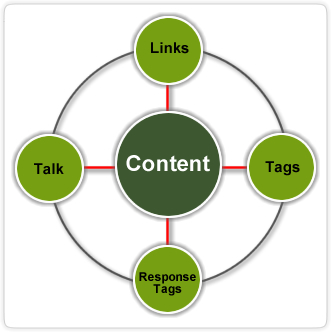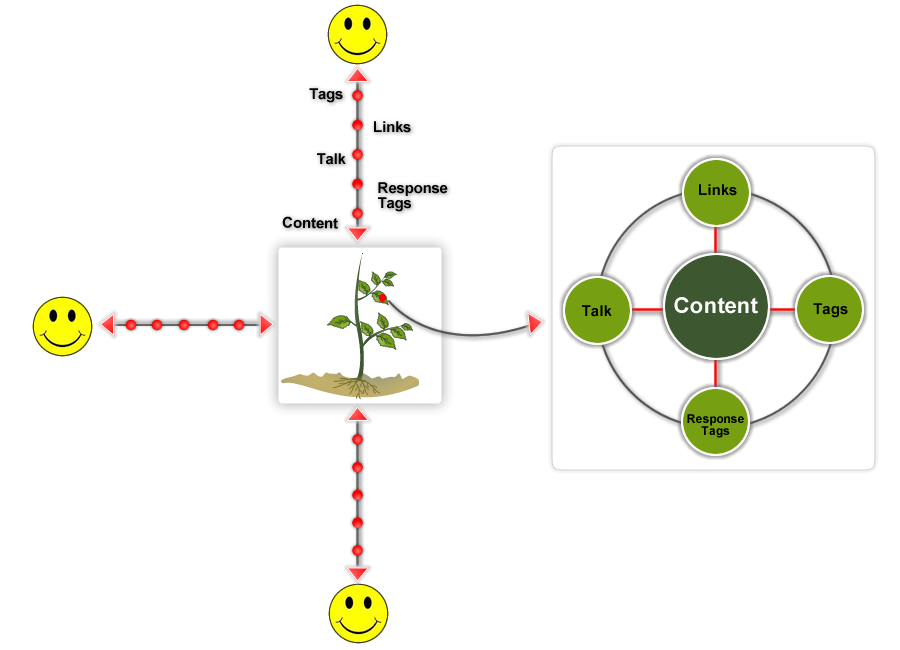Within Teeme collaboration is like growing a tree together. The leaves are the building block of the collaboration and collective contributions of the leaves form a tree. The leaf contains content and all the team interactions (conversations, actions & responses, tagging and linkages) on the content as collaborative unit and this enables deeper and transparent collaboration.
In fast changing business climate – the management itself need to collaborate deeper, wider, faster and open to lead the company. The following observations summarize the current practices and needs.
- For historical reasons we are still using personal productivity tools in team environments. Typically this means that we individually create content and then share collectively using email. This Inbox based collaboration model lead to create-share-review-share-revise-share cycles. The content, communications and team interactions are all captured through different tools in different repositories!
- Though interest and usage of social networking technologies are growing within business sector the application of these tools are limited to member profiling, connections and expertise discovery. The core bandwidth of users is unaffected by these tools.
- Businesses are partnering more to seek new opportunities and to gain competitive advantages. This requires cross-enterprise collaboration and now involves the customer as well.
- The teams collaborating now are – multi-disciplinary, distributed and located on different time zones.
- Web 2.0 and Wiki based systems have been around for some time but the core focuses of these applications have been content creation and share.
- Corporate governance requires transparent and traceable decisions making.
Teeme is designed for effective team collaboration for small focused single teams to distributed multi-disciplinary teams (employees, partners, suppliers and even customers - in different places and time zones). It also addresses key commercial concerns in managing collaboration namely trust management, transparency and traceability. Though Teeme uses social software concepts it applies them for real team work within enterprises.
Our mission is to enable Distributed Co-Creation.
The team work typically involves –
- Content creation, classification and linkages to other relate contents
- Conversations on content - for clarity, coverage, editorial and brainstorming purposes
- Interactions among team members for example review and accuracy requests, authorization and approval requests etc.
We believe that team work is like growing a tree together! Individual contributions are captured as leaf and these contributions collectively lead to growing the tree. A leaf contains a fully expressed thought. It can be a whole section of project scope, a topic in discussions or a few words specifying a task. This is the building block of team collaboration.

Figure#1
A leaf not only captures content it also provides tools for –
- Tags – The content is classified using simple tagging. The leaves and trees can be tagged. The tagging is consistent throughout the whole community.
- Response tags - Allow a user to request others to perform specific content related actions (for example review, check, verify etc.), select options, vote on an issue and seek authorization. Not only the actions but corresponding responses are captured with the tags - enabling transparency and feedback.
- Talk – This is a threaded conversation tool. The content related conversations can be captured right with the content using this.
- Links – A leaf or a tree can link other related content sources or trees using this feature.

Figure #2
Thus a leaf captures content, user interactions, conversations and other logical linkages. These conversations and interactions can lead to contributions of newer leaves. And thus the tree grows. Not only the tree captures the evolution of content but it also retains the conversations and user interactions which were responsible for the evolution. Any decision made by the team can be fully traced using this model – benefiting enterprises in auditing, governance and transparency.
 Figure# 3
Figure# 3
The following 6 different types of trees are provided to captures different collaborative patterns found in team situations.
1. Document tree – this provides a way to capture and evolve ideas as part of documentation activity. The document parts as leaves can evolve separately thus supporting micro-versioning. Macro-versioning at the document tree level is also provided.
2. Discussion tree – This captures multi-threaded discussion as topics and replies. The replies can attract replies as well. This tree is meant to capture deeper asynchronous communication.
3. Chat tree – Teeme Chat supports threaded synchronous and asynchronous communication. It provides both real-time views of the messages as well as logical threaded view. A chat tree can be reviewed and acted (tagging and linking) even after the chat is over. A chat can be restarted at any time – this is like having a series of phone-conferences and maintaining the context among these sessions for future reference.
4. Notes tree – This enables factual information about group activities to be captured effectively. For example client meeting, issue tracking, case management etc. Only participants of the group activity can edit content for Notes tree but others can still interact by tags, talk and links tool.
5. Contact tree – External clients, customers and other external stake-holders are modelled as Contact trees and all the interactions with this contact is captured in the tree. The tree captures basic elements of CRM.
6. Task tree – The task tree enables teams to develop, manage and monitor group tasks. A task can contain sub-tasks and these can be marked on Calendar. The tree is used for project monitoring and coordination purposes.
Teeme also provides features to create communities, form project teams and assign them work spaces for collaboration. The trust among the collaborative team is manged through spaces and subspaces which limit the visibility of information. The members have profiles and can send messages to each other.
Externally generated content can be imported and managed in Teeme. Teeme also supports both defined and ad-hoc collaboration model.
Teeme provides an innovative solution for collaboration among multi-disciplinary teams. Apart from the obvious productivity gains this enables businesses to make effective and transparent decisions.
- All the information (content, conversations and team interactions) is available to all team members at all times in one tool
- The decisions made can be influenced by all members
- The decisions made are transparent and traceable
- All the internal and external stakeholders can be involved in collaboration or rather co-creation!
- Choose a project carefully which involves cross-functional members. This will highlight the full potential of open collaboration.
- As the product does not impose any formal process of collaboration ; after initial few weeks - review the collboration pattern and usages of the tool. This will lead to better utilization of the tool and lead to more cohesive collboration.






You need to register in order to submit a comment.